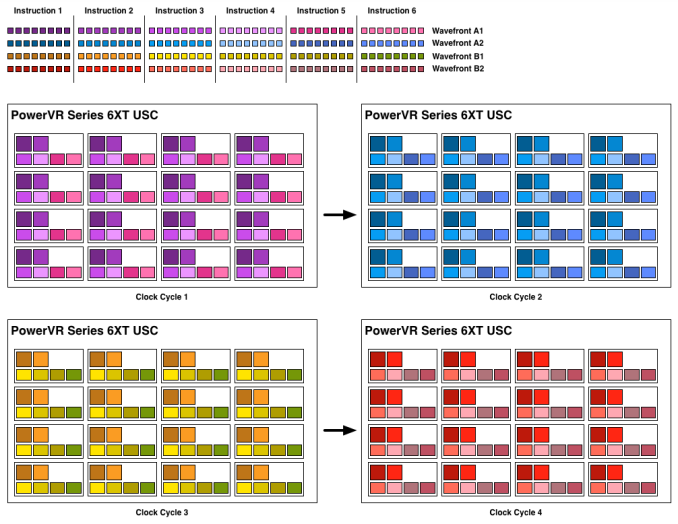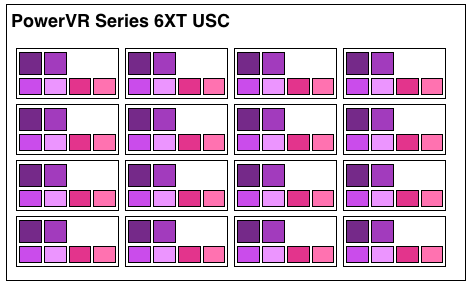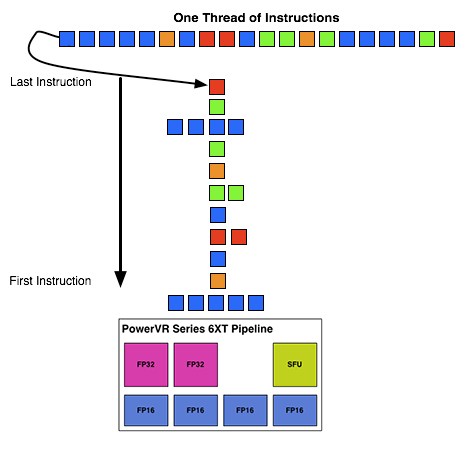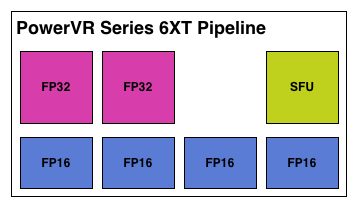Imagination's PowerVR Rogue Architecture Explored
by Ryan Smith on February 24, 2014 3:00 AM EST- Posted in
- GPUs
- Imagination Technologies
- PowerVR
- PowerVR Series6
- SoCs
How Rogues Get Executed: Wavefronts & Superscalar ILP
Now that we’ve seen the basic makeup of a single Rogue pipeline, let’s expand our view to the wider USC.
A single Rogue USC is comprised of 16 pipelines, making the design a 16 wide array. This, along with a texture unit, comprises one “cluster” when we’re talking about a multi-cluster (multiple USC) Rogue setup. In a setup with multiple USCs, the texture unit will then be shared among a pair of USCs.
We don’t have a great deal of information on the texture units themselves, but we do know that a Rogue texture unit can fetch 4 32bit bilinear texels per clock. So for a top-end 6 USC part, we’d be looking at a texture rate of 12 texels/clock.
Now by PC standards the Rogue pipeline/USC setup is a bit unusual due to its width. Both AMD and NVIDIA’s architectures are fairly narrow at this level, possessing just a small number of ALUs per shader core/pipeline. The impact of this is that by having multiple ALUs per pipeline in Rogue’s case, there is a need to extract some degree of instruction level parallelism (ILP) out of threads to feed as many ALUs as possible. Extracting ILP in turn requires having instructions in a single thread that have no dependencies on each other that can be executed in parallel. This can be many (but not all) instructions, so it’s worth noting that the efficiency of a USC is going to depend in part on the instructions in a thread. We call this property a superscalar design.
For the sake of comparison, AMD’s Graphics Core Next is not a superscalar design at all, while NVIDIA’s Kepler is superscalar in a similar manner. NVIDIA’s CUDA cores only have 1 FP32 ALU per core, but there are additional banks of CUDA cores that can be co-issued additional instructions, conditions permitting. So Rogue has a similar reliance on ILP within a thread, needing it to achieve maximum efficiency.
What makes Rogue all the more interesting is just how wide it is. For FP32 operations it’s only 2-wide, but if we throw in the FP16 operations we’re technically looking at a 6-wide design. The odds of having FP16 and FP32 operations ready to co-issue in such a manner is far rarer than having just a pair of FP32 instructions to co-issue, so again Rogue technically is very unlikely to achieve 100% utilization of a pipeline.
That said, the split between FP16 and FP32 units makes it clear that Imagination expects to be using one or the other most of the time rather than both, so as far as the design goes this is not unexpected. For FP32 instructions then it’s a simpler 2-wide setup, while FP16 instructions are going to be trickier as full utilization of FP16 is going to require a full 4 instruction setup (say 4 MADs following each other). The fact that Series 6XT has 4 FP16 units despite that is interesting, as it implies that it was worth the extra die space compared to the Series 6 setup of 2 FP16 units.
With that out of the way, let’s talk about how work is dispatched to the pipelines within a USC. Each pipeline works on one thread at a time, the same as any other modern GPU architecture. Consequently we’d expect the wavefront size to be 16 threads.
However there’s an interesting fact that we found out about the USCs, and that is that they don’t run at the same clockspeed throughout. The ALUs themselves run at the published clockspeed for the GPU, but the frontends that feed them – the decoders and operand collectors do not. Imagination has not specified at what rate they run at, but the only thing that makes sense is ½ the rate of the ALUs. So a 300MHz USC would have its decoder frontend running at 150MHz, etc.

An example of a wavefront executing. Instructions per thread not to scale
Consequently we believe that the size of a wavefront is not 16 threads, but rather 32 threads, executed over 2 cycles of the ALUs. This is not the first time we’ve seen this design – NVIDIA did something similar for their retired Fermi architecture – but this isn’t something we were expecting to see again. But with the idiosyncrasies of the SoC space, this is apparently something that still makes sense. Imagination did tell us that there are tangible power savings from doing this, and since SoC GPUs are power limited in most cases anyhow, this is essentially the higher performance option. Go faster by going slower.
Finally, this brings us to the highest level, the USC array. Each USC in an array receives its own thread to work on, so the number of threads actively being executed will be identical to the number of USCs in a design. For a high-end 6 module design, we’d be looking at 6 threads, whereas for a smaller 2 module design it would be just 2 threads.













95 Comments
View All Comments
grahaman27 - Monday, February 24, 2014 - link
Because apple can't have all the cool stuff!CiccioB - Monday, February 24, 2014 - link
Architecture wise, PowerVR seems more alike AMD's VLIW then nvidia's Kepler (or G200 or Fermi or Maxwell).That means PowerVR is going to have the same issues AMD had with VLIW and general computing performances and ILP.
There are also many interesting facts that could be analysed:
1. AMD went from having 5 computing ALUs to 4 to improve efficiency before switching to a completely new architetecture (CGN). PowerVR went from 5 to 7 ALUs (if we consider them all as separate units, are you sure it can process 16bit instructions togheter with 32bits one and not that those 32bits units can each execute 2x16bits instructions alternatively?)
2. PowerVR is using the same marketing politics used by AMD to count their computing core. They showed they had more computing core than nvidia competitor's architecture, but in the end, for the fact that they couldn't keep all of them feeded, they were less efficient.
3. nvidia passing from Kepler desktop to Kepler mobile removed ROPs and TMU. So, probably they think their architetcure (and GPUs on mobile in general) are less bottlenecked under those terms. PowerVR went incresing them, so they possibly think ROPs and TMU are more important then shaders... which is which? Both of them are trying to hide some deficiency of their respective architetcture?
4. We do not really know anything about PowerVR geometry power. nvidia in Kepler SMX has special function units (polymorph engine) that is connected directly to the shaders. That seems to give a enormous boost to geometric performaces (expecially tesselation) that rightly scale with the number of active SMX. PowerVR seems to have chosen AMD implementation with off-computational-core tesselator that do not scale automatically. How's going to behave PowerVR with future games that may need more geometric performances?
5. Again, as someone altready asked, tile based rendering was used on the desktop but was soon abandoned as it could not give any real advantages over the raw power of other architectures that grew much faster that what PowerVR could optimize their algorithms, making tile based rendering less and less profitable. What makes that scenario different that what we are witnessing in this period where mobile resolutions are growing to be even bigger than desktop monitors and that games complexity is gonig to increase for the arrival of these really powerful GPUs (K1 in primis)?
6. We lack the die area occupation comparison. How big is a 6 modules Rogue with respect to nvidia K1? If it is, just to say, twice nvidia die area, that would be a problem even thought the power consumption is the same. If it half, that would mean that PowerVR could make double K1 perfomance (if we believe Rogue 192 shaders perform like Kepler 192 ones). That would mean nvidia is in trouble just before beginning the high end socket race.
7. It seems PowerVR is behaving a bit like 3DFx did at the time, till it died. They were using their advanced but old technology to the exterme, so they rendered at 16bit instead of 32, used 16bit Zbuffer instead of 24 and many more "tricks" that were forced to try to hide what was quite clear: 3DFX didn't have the right architecture to compete with new companies like nvidia and ATI that started their story with the right step and much more powerful architectures (TNT2 simply destroyed Voodoo3 under all points, and beware, I was an Voodoo3 unfortunate owner). Will PowerVR go the same end trying to force the use of obsolete technics while all the others competitors are clearly pointing to constantly increasing raw power with no trade-offs (or with minimal ones?)
DanNeely - Monday, February 24, 2014 - link
AMDs shift from VLIW5 to VLIW4 was driven by the decline of DX9. DX9 was explicitly designed around a 5 step path; VLIW5 was tied directly to that. DX10's more flexible workflow rarely allowed for a 5 wide execution path.For VLIW4 AMD tied functional units together more than Imagination appears to've done here. They have 4 normal ALUs that match with the 4x 16bit ALUs in Rouge; but to do a special function operation they used 3 of the 32bit ALUs instead of using dedicated hardware. The tradeoff was that a special function cost a lot more normal processing capacity than it did before. Power VR doesn't appear to have put enough general purpose computing power place to do the same, and is required to use a dedicated SFU by default (even assuming they felt the tradeoff was worth like AMD does).
The main thing I'm curious about is if the 16 and 32bit ALUs are separate hardware; or if they implemented them similar to how SSE/AVX are done on x86 where the same hardware can do 2 32 (16) bit or 1 64 (32) bit operation.
http://www.anandtech.com/show/4061/amds-radeon-hd-...
Ryan Smith - Monday, February 24, 2014 - link
"The main thing I'm curious about is if the 16 and 32bit ALUs are separate hardware; or if they implemented them similar to how SSE/AVX are done on x86 where the same hardware can do 2 32 (16) bit or 1 64 (32) bit operation."They're separate hardware. Just as how NVIDIA uses separate FP32 and FP64 CUDA cores.
ryszu - Monday, February 24, 2014 - link
We're nothing like VLIW4/5, mobile Kepler still has ROPs and texture hardware, the area is absolutely nowhere near where you think it is and the architectural features we have in the front-end remain class leading and entirely sensible for mobile.CiccioB - Monday, February 24, 2014 - link
Sorry, maybe I was not that clear. I didn't meant they removed completely ROPs and TMUs, I was hinting to the fact that they decreased their number in a SMSX for mobile with respect to a SMX for desktop. ROPs are tied to memory channel, and that may be the cause. But TMUs are not, so they could be the same number as they are in desktop implementation.It seems nvidia sees those many ROPs and TMUs bottlenecked by RAM bandwidth so they spare space and power by not adding them.
PowerVR on the contrary has a ROPs and TMUs ratio with respect to shaders (or computing core) that is much higher. One or the other took the wrong assumption (also tied to the memory controller width, that may be higher as you want but costs in terms of die size and power). I'm curious to know who made it.
ryszu - Monday, February 24, 2014 - link
Ah, I see. Our ALU:TEX:ROP is different to Kepler (and again to Maxwell), yes. We're focused on still being strong for the basics (texturing, pixel fill) while still having a lot of shading to go with it. I can't speak for NV's design choices, just that both have pros and cons depending on market.The rest of your comment still has a lot of problems in respect to the PowerVR Rogue architecture and how it works, how it works in mobile, and how it compares to K1 and pre-GCN AMD.
Ryan Smith - Monday, February 24, 2014 - link
"Architecture wise, PowerVR seems more alike AMD's VLIW then nvidia's Kepler (or G200 or Fermi or Maxwell).That means PowerVR is going to have the same issues AMD had with VLIW and general computing performances and ILP."
To be honest I had the same thought at first. We've known that Rogue has multiple slots per pipeline since the Apple A7 came out, so when I first heard that I had the same thought. Given the greater simplicity of mobile SoCs, it would certainly make sense.
That said, after finally having access to IMG's technical details, it's clear to me that this is not the case, which was part of the reason I was so excited to work on this article. It's sort of like Fermi and it's sort of like VLIW5, but in reality it's neither.
The most important point is that in AMD's VLIW designs they had 4/5 ALUs all alike (for the sake of this discussion we'll ignore the T-unit). So to maximize a Streaming Processor's utilization, you needed to be able to extract a full 4-5 instructions of ILP out of a thread. Which was easy to do under DX9 (RGBA + lighting) and a lot harder to do under DX10.
Rogue on the other hand doesn't have ILP requirements nearly as high due to the fact that the 6 ALUs are not identical and are rarely all going to be in use at once (we don't even count the FP16 units in our GFLOPs calculations). They do have ILP requirements, unlike GCN, but for FP32 it's only 2 instructions for the 2 FP32 ALUs. This is in fact rather similar to Kepler (but not Maxwell) in that NVIDIA has a similar reliance on ILP to keep all of their CUDA cores fed. Half of the threads on Kepler need to co-issue another FP32 op to fill the other 64 CUDA cores in an SMX; Rogue is a bit worse in this regard since every thread needs to co-issue to fill every second FP32 ALU.
FP16 on the other hand is trickier, since that's a full 4 ALU setup. Worst case scenario is that IMG needs to pull off 4 instructions of ILP to maximize their utilization, but this is a bit murkier since we don't know why Series 6 had the unusual 3 operator FP16 ALUs in the first place. As such I'm less familiar with where FP16 is being used in mobile today, so it's harder to draw comparisons for what FP16 utilization may be like. That said, there's also the unknown of die size and power requirements of using FP16 units for FP16 math versus using FP32 units for the same task. I'm not sure if IMG has reason to be worried about FP16 utilization if they can pack 2x as much hardware in the same die size and power envelope.
Ultimately I'd classify Rogue as being closer to Fermi/Kepler than VLIW, which is why those are the comparisons we went with in the article. The 2 wide FP32 pipeline isn't nearly as narrow as AMD's VLIW, and the instructions themselves aren't the inflexible chaos that was VLIW as a language.
"Again, as someone altready asked, tile based rendering was used on the desktop but was soon abandoned as it could not give any real advantages over the raw power of other architectures that grew much faster that what PowerVR could optimize their algorithms, making tile based rendering less and less profitable. What makes that scenario different that what we are witnessing in this period where mobile resolutions are growing to be even bigger than desktop monitors and that games complexity is gonig to increase for the arrival of these really powerful GPUs (K1 in primis)?"
One of the problems IMG faced in the old days was that DirectX and Windows weren't very well suited for their TBDR design; they pretty much had to fight the API at times to get what they wanted. For iOS/Android it's difficult to draw comparisons - though I'd note iOS has always been driven by IMG GPUs and hence always used TBDR - but Windows for its part has since gotten much better. In particular there are API hooks to allow applications to see if the GPU is TBDR. I'm not sure if that's enough, but it does mean things have changed at least a little bit since the old days.
Scali - Monday, February 24, 2014 - link
In D3D11 there is now a flag to indicate whether you are running on a TBDR device or not: http://msdn.microsoft.com/en-us/library/windows/de...CiccioB - Monday, February 24, 2014 - link
I didn't realize that in counting those GFlops you ignored the 16bit ALUs, Issuing two instructions should be much easier than issuing 3, 4 or even 5, not to speak about 6 or 7.However I bet that PowerVR next architecture (or the next one again) will remove those 16bit ALUs and will introduce a couple of them able to issue 32 OR 2x16bit instruction, so that they can pack more shaders in the same area.
About TBDR design... the alternative to DirectX is OpenGL. Is it more suited for TBDR architecture than "brute force" ones?
Still I perceive PowerVR architecture as something from the past that has survived to to now until the big one have entered the mobile game for real. Kepler is a very efficient architecture and Maxwell has demonstrated that it can be even better. How is PowerVR going to fight against an architecture as flexible as nvidia ones that can also be used for CUDA computing and thus being adopted into markets (and for other tasks) PowerVR cannot with their current architecture? Not to forget that nvidia can now easily bring to their mobile versions whatever engine exists for their desktop GPUs.
Will extreme (but not so flexible) efficiency win against something not that efficient but able to do much more things in a easier way?
Would mobile game engines bet more on computing shaders power or memory bandwidth?
Will new DX10/DX11-alike engines (whose features are supported by new architectures) still be TBDR friendly? Does TBDR design still scale for the modern ultra high resolution displays or as for desktops "brute force" (or simply more power more performance) will rule out?
I think this year will tell us very much.